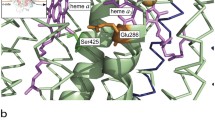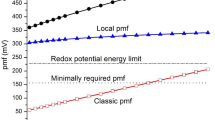Abstract
A detailed reaction cycle for cytochrome oxidase, an electron-transport-driven proton pump, has been presented earlier by our research group. The essential feature of the model is that both cytochrome a and CuA must be reduced in order to allow the transition from the electron and proton input state to the output state. The model is thus based on an indirect coupling between electron transfer and proton translocation.
In this study, the same model is examined with respect to (1) intrinsic electron and proton leaks and (2) the effect of applying an electrochemical potential gradient on the pump incorporated in a membrane, both with respect to the electrical and chemical components.
The model is successfully used to simulate various experimental results. Comparisons of experimental results with simulations based on the model support the existence of electron and proton leaks. The analysis of electron leaks suggests that electron gating is best achieved by varying the reorganization energy rather than by varying the reduction potentials.
It is also suggested that both the electrical and chemical components of the electrochemical potential gradient are responsible for the regulation of the enzyme activity. Furthermore, an attempt is made to interpret the seemingly contradictory results obtained when measuring the pH dependence of the reduction potential of cytochrome a. In addition, the simulations support the assumption that protons are pumped by a mechanism that combines a membrane Bohr effect with the transition-state mechanism.
Similar content being viewed by others
Abbreviations
- R :
-
molar gas constant
- k B :
-
Boltzmann contant
- F :
-
Faraday constant
- e :
-
elementary charge
- T :
-
absolute temperature
- \(\Delta \tilde \mu _H\) :
-
transmembrane electrochemical potential gradient
- ΔpH:
-
transmembrane pH difference
- pH1 and pH2 :
-
inside (matrix) and outside (cytosol) pH, respectively
- ΔΦ:
-
transmembrane electrical potential
- E m :
-
midpoint potential
References
WikströmM.: Protonic sidedness of the binuclear iron-copper centre in cytochrome oxidase, FEBS Lett. 231 (1988), 247–252.
WikströmM. K. F.: Proton pump coupled to cytochrome c oxidase in mitochondria, Nature 266 (1977), 271–273.
MalmströmB. G.: Cytochrome c oxidase as a proton pump. A transition-state mechanism, Biochim. Biophys. Acta 811 (1985), 1–12.
BlairD. F., GellesJ., and ChanS. I.: Redox-linked proton translocation in cytochrome oxidase: The importance of gating electron flow, Biophys. J. 50 (1986), 713–733.
KrabK. and WikströmM.: Principles of coupling between electron transfer and proton translocation with special reference to proton-translocation mechanisms in cytochrome oxidase, Biochim. Biophys. Acta 895 (1987), 25–39.
BrzezinskiP. and MalmströmB. G.: The mechanism of electron gating in proton pumping cytochrome c oxidase: the effect of pH and temperature on internal electron transfer, Biochim. Biophys. Acta 894 (1987), 29–38.
MalmströmB. G.: Coupling between electron transfer and proton translocation in cytochrome c oxidase, Chem. Scr. 27B (1987), 67–72.
ThörnströmP.-E., BrzezinskiP., FredrikssonP.-O., and MalmströmB. G.: Cytochrome c oxidase as an electron-transport-driven proton pump: pH dependence of the reduction levels of the redox centers during turnover, Biochemistry 27 (1988), 5441–5447.
GellesJ., BlairD. F., and ChanS. I.: The proton pumping site of cytochrome c oxidase: a model of its structure and mechanism, Biochim. Biophys. Acta 853 (1986), 205–236.
McGovern MoroneyP., ScholesT. A., and HinkleP. C.: Effect of membrane potential and pH gradient on electron transfer in cytochrome oxidase, Biochemistry 23 (1984), 4991–4997.
BrunoriM., SartiP., ColosimoA., AntoniniG., MalatestaF., JonesM. G., and WilsonM. T.: Mechanism of control of cytochrome oxidase activity by the electrochemical-potential gradient, EMBO J. 4 (1985), 2365–2368.
MurphyM. P. and BrandM. D.: The control of electron flux through cytochrome oxidase, Biochem. J. 243 (1987), 499–505.
Maison-PeteriB. and MalmströmB. G.: Intrinsic uncoupling in proton-pumping cytochrome c oxidase: pH dependence of cytochrome c oxidation in coupled and uncoupled phospholipid vesicles, Biochemistry 28 (1989), 3156–3160.
WikströmM.: Properties of cytochrome oxidase relevant to its proton-translocating function, in ChienHo (ed.) Electron Transport and Oxygen Utilization, Elsevier-North Holland, Amsterdam, 1982.
PapaS.: Cytochrome c oxidase and its protonmotive activity, an overview, Prog. Clin. Biol. Chem. 247 (1988), 707–729.
PietrobonD., ZorattiM., AzzoneG. F., and CaplanR. S.: Intrinsic uncoupling of mitochondrial proton pumps. 2. Modeling studies, Biochemistry 25 (1986), 767–775.
MalmströmB. G. and NilsonT.: Intermediate states and electron gatng in proton-pumping cytochrome c oxidase, Ann. NY Acad. Sci. 550 (1988), 177–184.
BoorkJ. and WennerströmH.: The influence of membrane potentials on reaction rates control in free-energy-transducing systems, Biochim. Biophys. Acta 767 (1984), 314–320.
ReynoldsJ. A., JohnsonE. A., and TanfordC.: Incorporation of membrane potential into theoretical analysis of electrogenic ion pumps, Proc. Natl. Acad. Sci. USA 82 (1985), 6869–6873.
PietrobonD. and CaplanR. S.: Flow-force relationships for a six-state proton pump model: intrinsic uncoupling, kinetic equivalence of input and output forces, and domain of approximate linearly, Biochemistry 24 (1985), 5764–5776.
GregoryL. C. and Ferguson-MillerS.: Ann. NY Acad. Sci. 550 (1988), 260–268.
WikströmM.: Mechanism of cell respiration, Chem. Scr. 28A (1988), 71–74.
OhnishiT., LoBruttoR., SalernoJ. C., BrucknerR. C.,and FrayT. G.: Spatial relationship between cytochrome a and a 3, J. Biol. Chem. 257 (1982), 14821–14825.
ChanS. I., BrudvigG. W., MartinC. T. and StevensT. H.: The nature and the distribution of the metal centres in cytochrome c oxidase, in ChienHo (ed.) Electron Transport and Oxygen Utilization, Elsevier-North Holland, Amsterdam, 1982.
SoneN. and HinkleP. C.: Proton transport by cytochrome c oxidase from the thermophilic bacterium PS3 reconstituted in liposomes, J. Biol. Chem. 257 (1982), 12600–12604.
ZorattiM., FavaronM., PietrobonD., and AzzoneG. F.: Intrinsic uncoupling of mitochondrial proton pumps. I. Non-ohmic conductance cannot account for the nonlinear dependence of static head respiration on 263-1, Biochemistry 25 (1986), 760–767.
WilsonD. F., OwenC. S., and HolianA.: Control of mitochondrial respiration: a quantitative evaluation of the roles of cytochrome c and oxygen, Arch. Biochem. Biophys. 182 (1977), 749–762.
BrzezinskiP. and MalmströmB. G.: Electron-transport-driven proton pumps display nonhyperbolic kinetics: simulation of the steady-state kinetics of cytochrome c oxidase, Proc. Natl. Acad. Sci. USA 83 (1986), 4282–4286.
MarcusR. A. and SutinN.: Electron transfer in chemistry and biology, Biochim. Biophys. Acta 811 (1985), 265–322.
BoelensR., WeverR., and VanGelderB. F.: Electron transfer after flash photolysis of mixed-valence carboxycytochrome c oxidase, Biochim. Biophys. Acta 682 (1982), 264–272.
GrayH. B. and MalmströmB. G.: Long-range electron transfer in multisite metalloproteins, Biochemistry 28 (1989), 7499–7505.
WikströmM., HarmonJ. H., IngledewJ. W., and ChanceB.: A re-evaluation of the spectral, potentiometric and energy-linked properties of cytochrome c oxidase in mitochondria, FEBS Lett. 65 (1976), 259–277.
EllisW. R.Jr., WangH., BlairD. F., GrayH. B., and ChanS. I.: Spectroelectrochemical study of the cytochrome a site in carbon monoxide inhibited cytochrome c oxidase, Biochemistry 25 (1986), 161–167.
ArtzatbanovYu. V., KonstantinovA. A., and SkulachevV. P.: Involvement of intramitochondrial protons in redox reactions of cytochrome a, FEBS Lett. 87 (1978), 180–185.
BlairD. F., EllisW. R.Jr., WangH., GrayH. B., and ChanS. I.: Spectroelectrochemical study of cytochrome c oxidase: pH and temperature dependences of the cytochrome potentials, J. Biol. Chem. 261 (1986), 11524–11537.
PetersenL. C. and AndréassonL.-E.: The reaction between oxidized cytochrome c and reduced cytochrome c oxidase, FEBS Lett. 66 (1976), 52–57.
Author information
Authors and Affiliations
Rights and permissions
About this article
Cite this article
Brzezinski, P. A reaction cycle for cytochrome c oxidase as an electron-transport-driven proton pump: The effect of electrochemical potential and slips. J Biol Phys 17, 245–263 (1990). https://doi.org/10.1007/BF00386600
Received:
Revised:
Issue Date:
DOI: https://doi.org/10.1007/BF00386600




